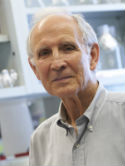| Abstract: |
The receptor tyrosine kinase c-kit is thought to mediate its diverse effects on different cell lineages by association and activation of distinct second messenger systems. One of the immediate events after binding of the kit ligand to the receptor is its association with the 85-kDa subunit (p85) of the phosphatidylinositol (PI) 3-kinase and the activation of the enzyme. In the present study, we examined the association and activation of PI 3- kinase with mutant forms of the c-kit receptor transiently expressed in COS- 1 cells. To define the binding site of p85 we substituted the putative tyrosine phosphorylation sites in the kinase insert region of the c-kit receptor by phenylalanine (YF702, YF719, YF728, and YF745, respectively). The results indicate that, upon stimulation of cells with kit ligand, 1) the wild-type c-kit protein was readily autophosphorylated and autophosphorylation was not diminished significantly with any of the mutant proteins; 2) p85 and PI 3-kinase activity associated with wild-type c-Kit protein as well as with the mutant proteins YF702, YF728, and YF745. Ligand- induced association of p85 and PI 3-kinase activity were abolished with the YF719 c-Kit protein, and this was not due to different levels of expression of p85 or c-kit; and 3) c-kit receptor-bound p85 was not phosphorylated on tyrosine residues. These results indicate that tyrosine 719 within the 719YMDM motif in the kinase insert plays an important role in binding of p85 and that its phosphorylation is a prerequisite for binding of p85 and the subsequent activation of PI 3-kinase. |



